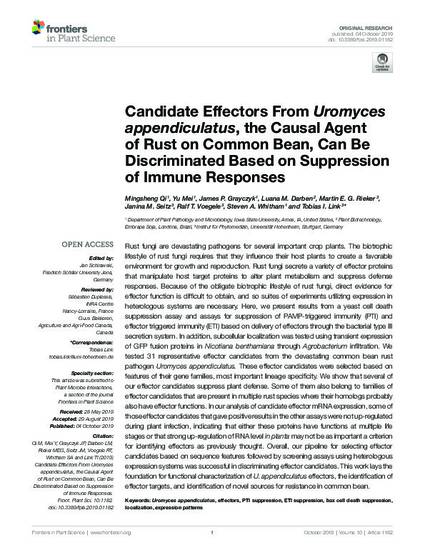
Rust fungi are devastating pathogens for several important crop plants. The biotrophic lifestyle of rust fungi requires that they influence their host plants to create a favorable environment for growth and reproduction. Rust fungi secrete a variety of effector proteins that manipulate host target proteins to alter plant metabolism and suppress defense responses. Because of the obligate biotrophic lifestyle of rust fungi, direct evidence for effector function is difficult to obtain, and so suites of experiments utilizing expression in heterologous systems are necessary. Here, we present results from a yeast cell death suppression assay and assays for suppression of PAMP-triggered immunity (PTI) and effector triggered immunity (ETI) based on delivery of effectors through the bacterial type III secretion system. In addition, subcellular localization was tested using transient expression of GFP fusion proteins in Nicotiana benthamiana through Agrobacterium infiltration. We tested 31 representative effector candidates from the devastating common bean rust pathogen Uromyces appendiculatus. These effector candidates were selected based on features of their gene families, most important lineage specificity. We show that several of our effector candidates suppress plant defense. Some of them also belong to families of effector candidates that are present in multiple rust species where their homologs probably also have effector functions. In our analysis of candidate effector mRNA expression, some of those effector candidates that gave positive results in the other assays were not up-regulated during plant infection, indicating that either these proteins have functions at multiple life stages or that strong up-regulation of RNA level in planta may not be as important a criterion for identifying effectors as previously thought. Overall, our pipeline for selecting effector candidates based on sequence features followed by screening assays using heterologous expression systems was successful in discriminating effector candidates. This work lays the foundation for functional characterization of U. appendiculatus effectors, the identification of effector targets, and identification of novel sources for resistance in common bean.
Available at: http://works.bepress.com/steven-whitham/47/

This article is published as Qi M, Mei Y, Grayczyk JP, Darben LM, Rieker MEG, Seitz JM, Voegele RT, Whitham SA and Link TI (2019) Candidate Effectors From Uromyces appendiculatus, the Causal Agent of Rust on Common Bean, Can Be Discriminated Based on Suppression of Immune Responses. Front. Plant Sci. 10:1182. doi: 10.3389/fpls.2019.01182.